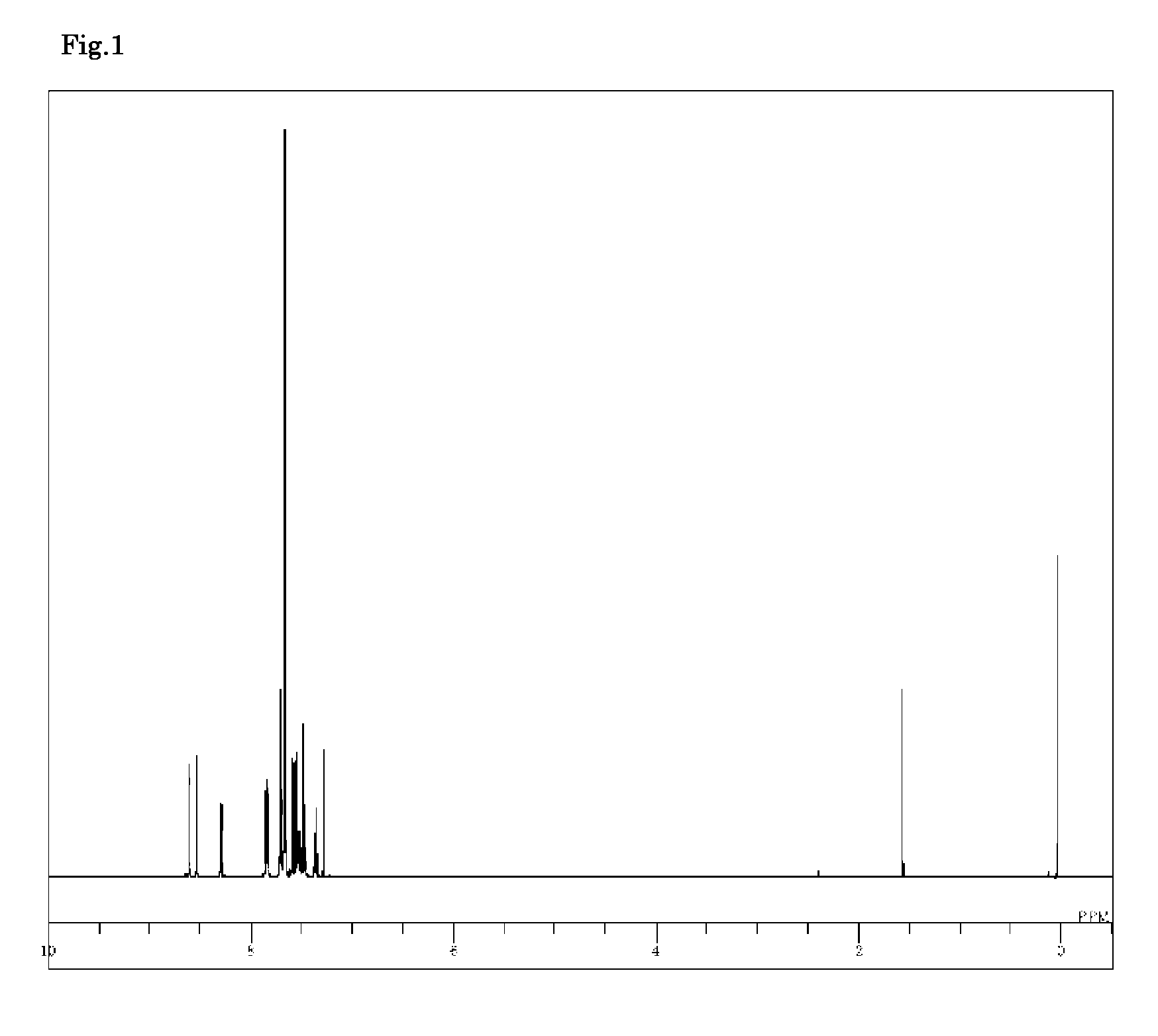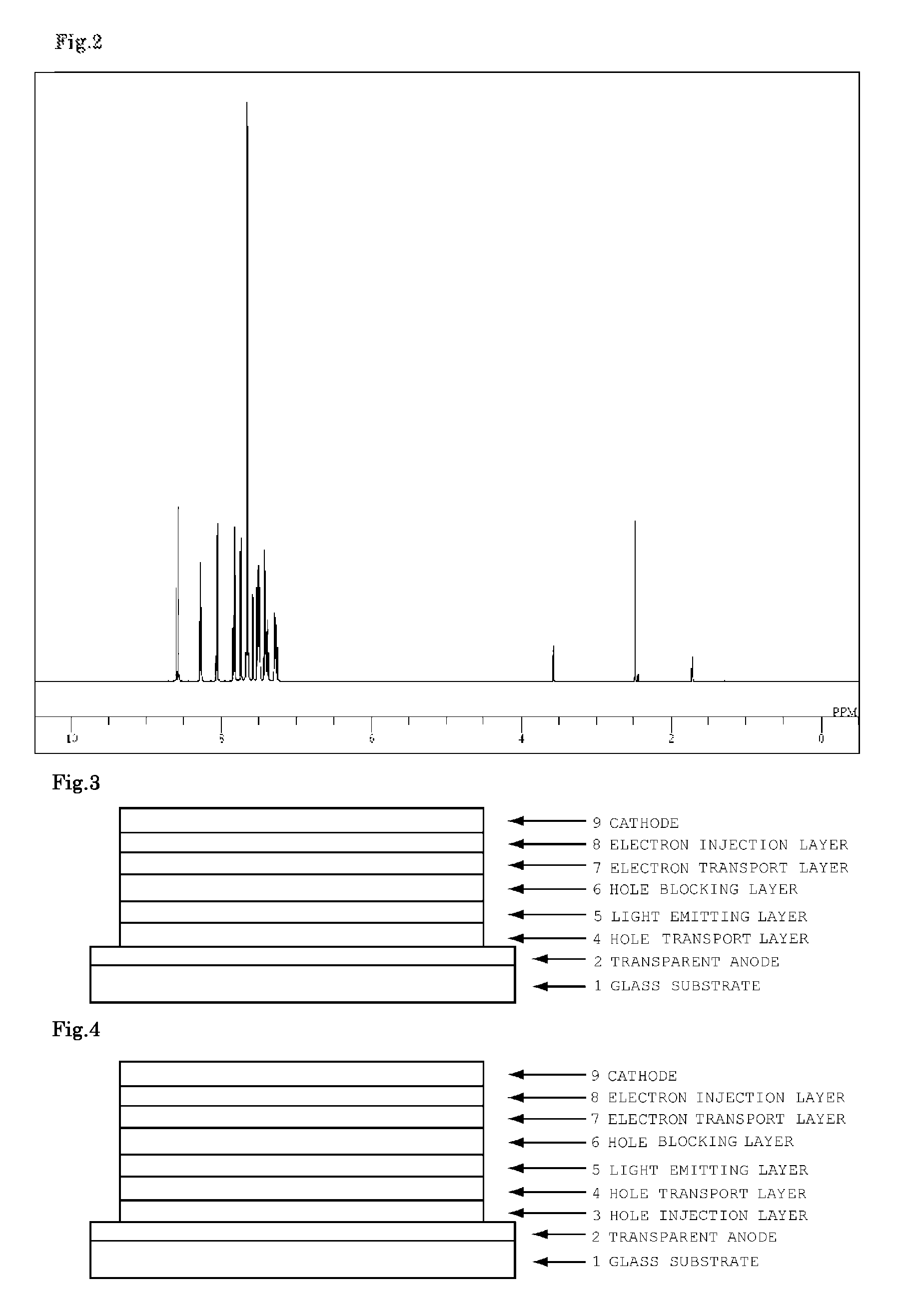Organic electroluminescent device
a technology of electroluminescent devices and organic materials, which is applied in the direction of solid-state devices, semiconductor devices, organic chemistry, etc., can solve the problems of insufficient electron blocking performance of compounds, low hole mobility of tapc, and inability to improve luminous efficiency, etc., to achieve excellent triplet exciton confining capability, stable thin-film state, and heat resistance. excellent
- Summary
- Abstract
- Description
- Claims
- Application Information
AI Technical Summary
Benefits of technology
Problems solved by technology
Method used
Image
Examples
example 1
Synthesis of 3,6-bis(9′-phenyl-9′H-carbazol-3-yl)-9-phenyl-9H-carbazole (Compound 5)
[0111]3,6-Dibromo-9-phenyl-9H-carbazole (1.6 g), 9-phenyl-3-(4,4,5,5-tetramethyl-1,3,2-dioxabororan-2-yl)-9H-carbazole (2.4 g), toluene (20 ml), ethanol (5 ml), and a 2 M potassium carbonate aqueous solution (6 ml) were added to a nitrogen-substituted reaction vessel, and aerated with nitrogen gas for 30 minutes under ultrasonic waves. The mixture was heated after adding tetrakis(triphenylphosphine)palladium (0.23 g), and stirred at 74° C. for 4 hours. After adding toluene (80 ml), the mixture was heated, and further stirred at 70° C. for 1 hour. The mixture was then cooled to 40° C., and the insolubles were removed by filtration. The filtrate was then concentrated under reduced pressure to obtain a black crude product. Toluene (100 ml) was added to dissolve the crude product, and the solution was subjected to adsorptive purification with a silica gel (28.9 g), and concentrated under reduced pressure...
example 2
Synthesis of 9′-phenyl-9-[4-(9-phenyl-9H-carbazol-3-yl)-phenyl]-9H,9′H-[3,3′]bicarbazolyl (Compound 26)
[0114]9-Phenyl-9H,9′H-[3,3′]bicarbazolyl (12.9 g), 4-bromo-iodobenzene (13.4 g), a copper powder (0.64 g), potassium carbonate (8.34 g), sodium bisulfite (0.49 g), and orthodichlorobenzene (50 ml) were added to a nitrogen-substituted reaction vessel, heated, and stirred at 170° C. for 19.5 hours. The mixture was cooled to 90° C., and dissolved after adding toluene (200 ml). After removing the insolubles by filtration, the filtrate was concentrated under reduced pressure, and crystallized from methanol (50 ml) to obtain a white powder of 9-(4-bromophenyl)-9′-phenyl-9H,9′H-[3,3′]bicarbazolyl (17.30 g; yield 97%).
[0115]The resulting 9-(4-bromophenyl)-9′-phenyl-9H,9′H-[3,3′]bicarbazolyl (17.00 g), 9-phenyl-3-(4,4,5,5-tetramethyl-1,3,2-dioxabororan-2-yl)-9H-carbazole (12.25 g), toluene (160 ml), ethanol (40 ml), and a 2 M potassium carbonate aqueous solution (23 ml) were added to a nitr...
example 3
[0118]The glass transition points of the compounds used in the present invention were determined using a high-sensitive differential scanning calorimeter DSC 3100S produced by Bruker AXS.
[0119]
Glass transitionpointCompound of Example 1 of the present invention142.5° C.Compound of Example 2 of the present invention151.4° C.
[0120]The compounds used in the present invention have glass transition points of 100° C. or higher, demonstrating that the compounds used in the present invention have a stable thin-film state.
PUM
| Property | Measurement | Unit |
|---|---|---|
| luminance | aaaaa | aaaaa |
| external quantum efficiency | aaaaa | aaaaa |
| work function | aaaaa | aaaaa |
Abstract
Description
Claims
Application Information
 Login to View More
Login to View More - R&D
- Intellectual Property
- Life Sciences
- Materials
- Tech Scout
- Unparalleled Data Quality
- Higher Quality Content
- 60% Fewer Hallucinations
Browse by: Latest US Patents, China's latest patents, Technical Efficacy Thesaurus, Application Domain, Technology Topic, Popular Technical Reports.
© 2025 PatSnap. All rights reserved.Legal|Privacy policy|Modern Slavery Act Transparency Statement|Sitemap|About US| Contact US: help@patsnap.com



